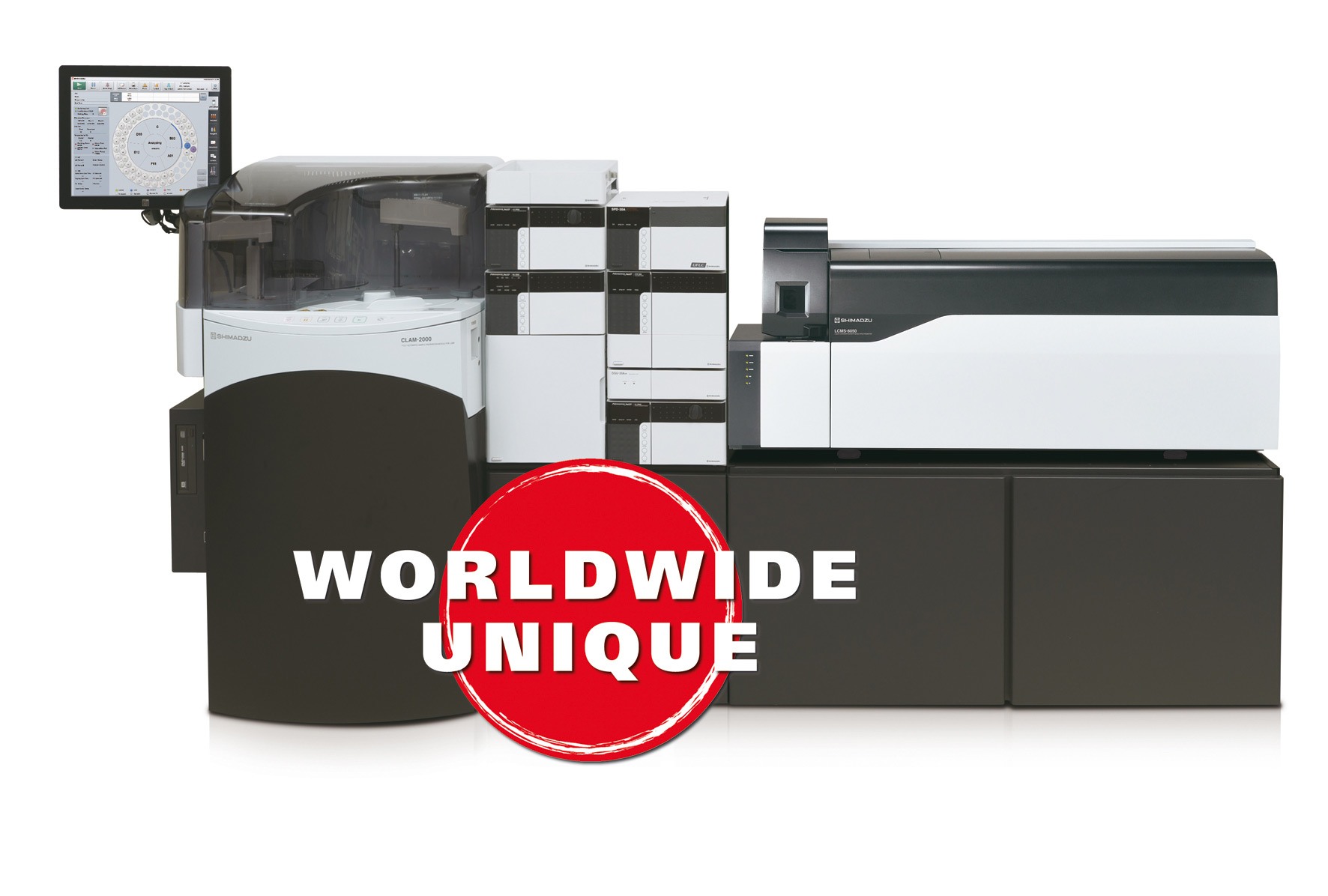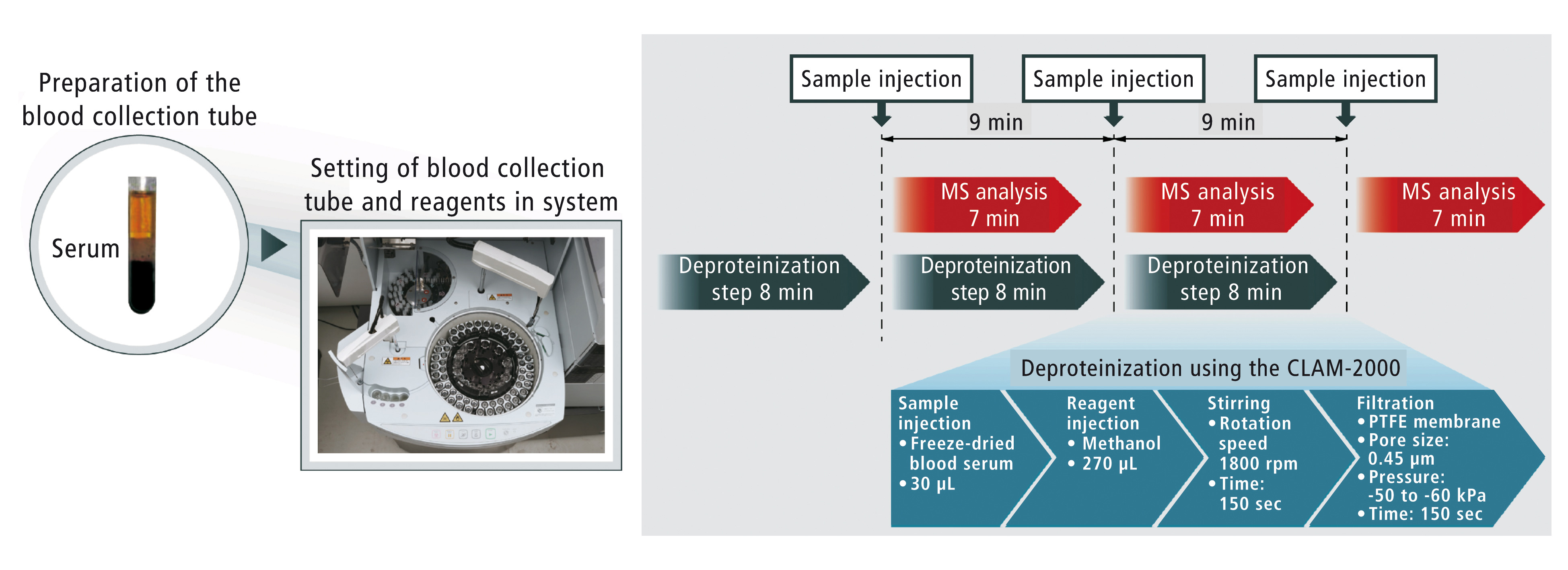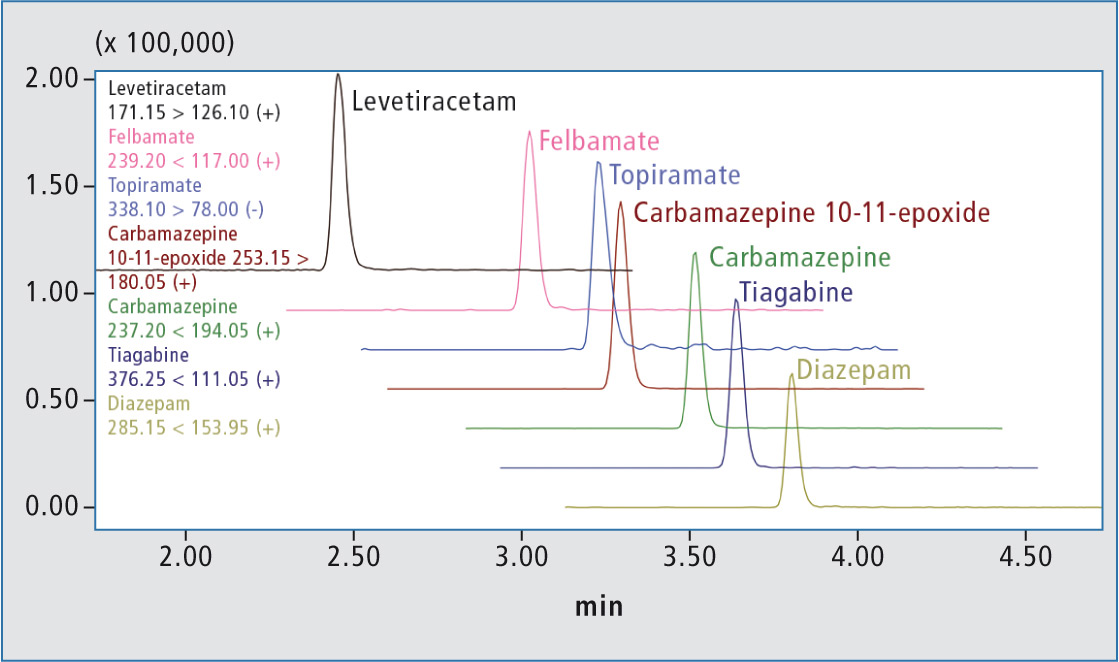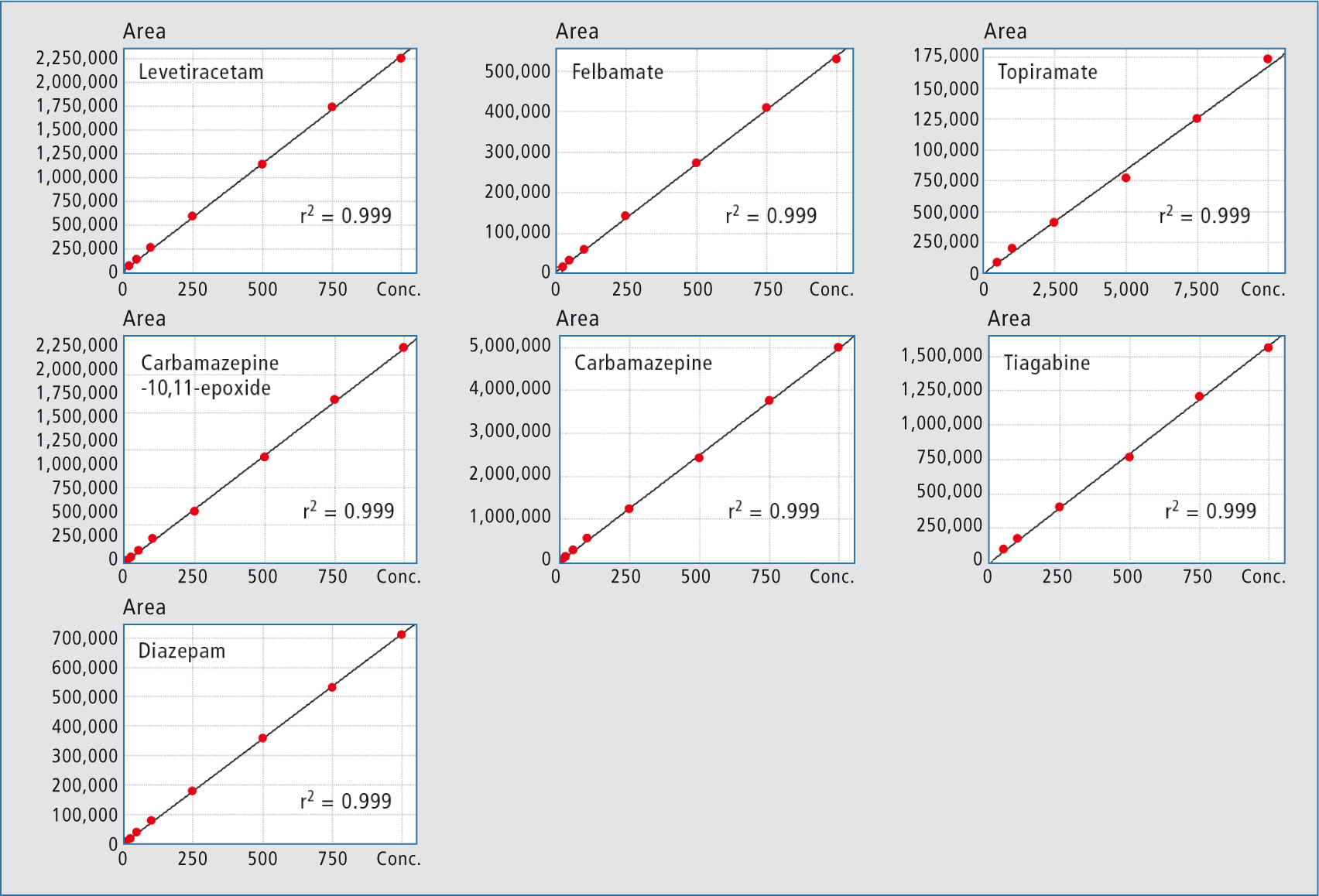Discover the future of LC-MS/MS
CLAM-2000* – fully automated sample preparation module particularly for biological applications
The trend to use LC-MS/MS technology instead of immuno assays in clinical laboratories can be observed already for a few years. The shift to LC-MS/MS is constantly increasing for several types of analysis, for example immunosuppressants, vitamin D or steroids panels. The progress of LC-MS/MS in that field is mainly due to its ability for high sensitivity detection, high selectivity as well as the possibility to multiplex compounds in one analysis without the risk of inspecific cross reactions inherent to immunoassay tests.
Sample preparation is the bottleneck
LC-MS/MS has proven to be a powerful tool in clinical laboratories and the cost per analysis was decreased significantly – thanks to Shimadzu’s UFMS (Ultra-Fast Mass Spectrometry) technologies including ultra-fast polarity switching (5 ms), short pause time (1 ms), multi MRM (555 per second), and fast scanning possibilities (30,000 Da/s), combined with the well-known robustness of Shimadzu systems.
However, the bottleneck still remains sample preparation steps like deproteinization and dilution which is required to analyze blood samples. These steps are often tedious, introduce the risks of errors, and also increase the potential health risk due to infection for laboratory staff. To overcome this, Shimadzu has developed the fully automated sample preparation module CLAM-2000 (Clinical Laboratory Automated sample preparation Module).
Unique combination of sample preparation and LC-MS/MS analysis
The CLAM-2000 (figure 1) is an automated pretreatment system designed for customers that handle biological samples like blood serum, blood plasma or urine in pharmaceutical and medical departments, or biological analysis laboratories that are dealing with issues of variability in analytical results or infection risk. It is a fully automated sample preparation module that was developed based on Shimadzu’s experience to produce clinical analyzers. The instrument is able to perform the following processes for sample pretreatment:
 Figure 1: CLAM-2000 fully automated sample preparation LC-MS/MS system
Figure 1: CLAM-2000 fully automated sample preparation LC-MS/MS system
- dispensing samples
- dispensing reagents
- stirring
- suction filtration
- incubation
- automatic transfer of sample vials to an
SIL-30AC auto-sampler after pretreatment.
The direct detection of diseases related to biological compounds in blood, urine, or other biological samples, the measurement of trace concentration levels of drugs and other applications is possible by mass spectrometry. By additionally using the CLAM-2000 unit in front of the LC-MS/MS system, data quality will not only be improved, but also throughput will be increased. Simply, the blood collection tubes have to be placed in the system and the CLAM-2000 will perform all other processes from sample pretreatment to LC-MS analysis automatically.
Unlike standard dispensing systems or robots, which are based on batch processing of 96-well plates, the CLAM-2000 is completely automated. No manual steps are required after placing the samples as even the transfer to the LC-MS/MS instrument is done automatically. It processes all individual samples successively. Consequently, it results in uniform pretreatment times for every sample, without slowing down processing speed, and improves data reproducibility and accuracy.
Fully automated analysis of blood serum
Figure 2 shows as an example the workflow for the simultaneous analysis of antiepileptic drugs in blood serum using the CLAM-2000 coupled to a LCMS-8040 mass spectrometer. The blood collection tubes were inserted into the CLAM-2000 and the analysis was started on the touch panel. Additional samples may be inserted while the instrument is already running.
 Figure 2: Workflow for simultaneous analysis of antiepileptic drugs in blood serum using the fully automated sample preparation LC-MS/MS system
Figure 2: Workflow for simultaneous analysis of antiepileptic drugs in blood serum using the fully automated sample preparation LC-MS/MS system
Preparation of the next sample can also be performed in parallel with LC/MS/MS analysis, which can greatly reduce the time required for each sample analysis. In the instant example, a per-sample cycle time including analysis of nine minutes is achieved. The mass chromatogram (figure 3) shows the separation of seven antiepileptic drugs and drug metabolites spiked into human blood serum. Due to the selective detection of the LC-MS based on mass and structure, no interferences from other components in the blood serum are apparent.
 Figure 3: Mass chromatogram of seven antiepileptic drugs and drug metabolites in a control serum sample
Figure 3: Mass chromatogram of seven antiepileptic drugs and drug metabolites in a control serum sample
Calibration curves were prepared by continuous analysis with fully automated sample preparation and analysis, and used to assess accuracy and precision (repeatability). Good linearity was obtained across the set calibration curve range for each antiepileptic drug (figure 4), with accuracy within 100 % ± 15 % over the entire measurement range including the minimum limit of quantification. Similarly, precision was measured at a % RSD of within 15 %, showing that good repeatability was achieved (table 1).
 Figure 4: Calibration curves of seven antiepileptic drugs and drug metabolites
Figure 4: Calibration curves of seven antiepileptic drugs and drug metabolites
 Table 1: Results of validation test for simultaneous analysis of antiepileptic drugs
Table 1: Results of validation test for simultaneous analysis of antiepileptic drugs
Flexible and future-proof
The system is not limited to certain methods and allows the use of homebrew methods as well as commercially available kits as long as the manual preparation steps can be adapted on the system. The required reagents just have to be inserted into the system, and the respective method have to be assigned to the sample.
In addition, to keep a maximum degree of flexibility and to be able to adapt to future needs, the CLAM-2000 is compatible with the full range of Shimadzu’s LC-MS/MS instruments:
- LCMS-8040
- LCMS-8050
- LCMS-8060
The CLAM-2000 can easily be added to an already existing LC-MS/MS system. A simple Graphic User Interface (GUI) via a touch panel simplifies the monitoring of the unit (sample preparation plus LCMS system) as well as tables to follow the work load of the system and tools to organize the maintenance. Samples can be easily entered and tracked by the integrated barcode reader.
Consequently, the new CLAM-2000 is the first system in the world able to perform all steps fully automated from pretreatment of the sample to LC-MS/MS analysis without any further manual interaction. It just requires the simple task of placing the blood, or biological fluids collection tubes, reagents, internal standards and specialized pretreatment vials in the system and start.
It also features excellent management functions that can provide a dramatically improved workflow with better safety for clinical research and higher reproducibility.
*For Research Use Only. Not for use in diagnostic procedures. Not available in the USA, Canada and China.
Further information on this article
Application News High-Throughput Optimization of Therapeutic Drug Monitoring